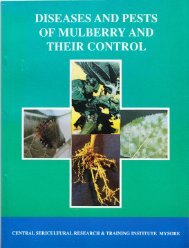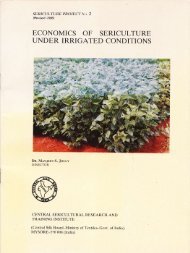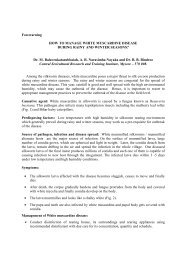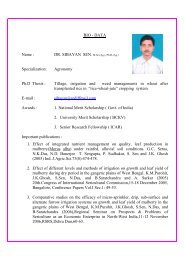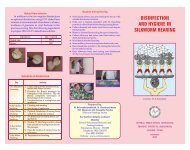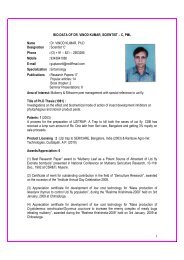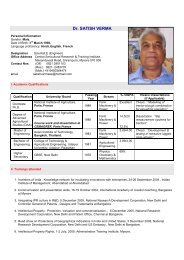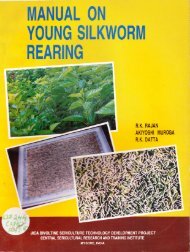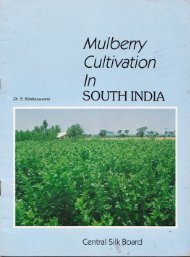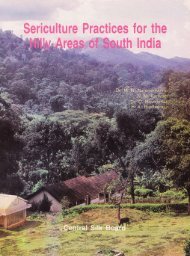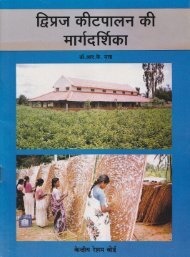E}A]\GALORE
Improved Method Rearing Younf Age (Young) Silkworms - Central ...
Improved Method Rearing Younf Age (Young) Silkworms - Central ...
- No tags were found...
You also want an ePaper? Increase the reach of your titles
YUMPU automatically turns print PDFs into web optimized ePapers that Google loves.
It may be seen from the above that spacing' is required to be increased<br />
systematically at every stage of growth of the chawki worms. For example, in the case<br />
of 3'x2' x3" wooden tray with 10 layings brushed, the spacing is increased from a bed<br />
size of 6"x9' to that of 9"x12" over a period of 24 hours from the time of brushing.<br />
This is achieved gradually by increasing the spacing at every feed during lhe24 5ours.<br />
period' ln this way, spacing is increased every day of the rearing. The object in doing<br />
so is to ensure maximum development of all the larvae .uniformly by providing required<br />
space as they grow. Further, it helps to keep the bed thin (i.e., less than 1/2,, in height)<br />
and this assists in the drying of beds prior to every feeding. lt is well to remember here<br />
that thick beds, which cannot be dried easily and which tend to build up bed humidity<br />
beyond 90 per cent will lead to the outbreak of Muscardine and Grasserie diseases.<br />
H. Feeding:<br />
As already pointed out in Bulletin No. 2 on the 'New Technology of Silkworm<br />
Rearing', the young age silkworms are led thrice or four times during fhe day<br />
depending upon the seasonal weather conditions. ln wet weather, when the<br />
atmospheric humidity as well as moisture content in the leaf are on the higher side,<br />
only three feeds need be given at 6 a.m. 1 p.m. and B p.m. During othei seasons<br />
including summer months, however, four feeds may be found necessary, which may be<br />
given at 6 a.m., 11 a.m., 3 p.m.and B p.m. As regards the quantity of leaf to be fed<br />
to the chawki worms, it has already been indicated (Bulletin No. 2) that the leaf<br />
requiremenl for 100 layings (with average of 400 eggs per laying) during the first age<br />
will be about 2 to 2'5 kg. for the improved multivoltine hybrids and about 2.5 to 3 kg.<br />
for the new bivoltine hybrids. For the second age worms, the leaf requirement will be<br />
6 to 7 kg. for the improved multivoltine hybrids and 8 to 9 kg. for the new bivoltine<br />
hybrids.<br />
ln the case of rearing ol chawki worms, great care and attention have to be<br />
given to the method of feeding as well, in addition to the correct way of chopping,<br />
optimum quantity of feed, number of feedings to be given etc. Unless the correct<br />
method of feeding is adopted, the oblectives of chawki rearing, namely raising of<br />
vigorously growing larvae of robust health and unilorm development will not be fully<br />
realised. The correct method of feeding is described below:<br />
lmmediately after brushing, the rearing bed is made up, with due spacing<br />
prescribed (as already described) and covered with paraffin paper. lf required, the wet<br />
paper or wet foam rubber band is placed around the rearing bed in between the paraffin<br />
paper sheets. The trays are later piled up one over the other to a convenient height.<br />
Thereafter, prior to every feeding that is to follow, the procedure described hereunder<br />
should be meticulously adopted.<br />
Half an hour prior to feeding, the paraffin paper cover should be removed and so<br />
also the wet paper or wet foam rubber band from the tray. Then the tray is placed on<br />
20


![E}A]\GALORE](https://img.yumpu.com/54052619/23/500x640/eagalore.jpg)

